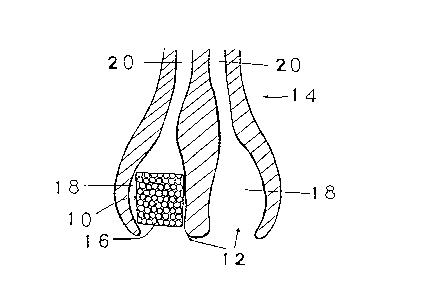Une partie des informations de ce site Web a été fournie par des sources externes. Le gouvernement du Canada n'assume aucune responsabilité concernant la précision, l'actualité ou la fiabilité des informations fournies par les sources externes. Les utilisateurs qui désirent employer cette information devraient consulter directement la source des informations. Le contenu fourni par les sources externes n'est pas assujetti aux exigences sur les langues officielles, la protection des renseignements personnels et l'accessibilité.
L'apparition de différences dans le texte et l'image des Revendications et de l'Abrégé dépend du moment auquel le document est publié. Les textes des Revendications et de l'Abrégé sont affichés :
| (12) Brevet: | (11) CA 2003895 |
|---|---|
| (54) Titre français: | INTRANASAL FILTER |
| (54) Titre anglais: | FILTRE INTRA-NASAL |
| Statut: | Périmé et au-delà du délai pour l’annulation |
| (51) Classification internationale des brevets (CIB): |
|
|---|---|
| (72) Inventeurs : |
|
| (73) Titulaires : |
|
| (71) Demandeurs : | |
| (74) Agent: | |
| (74) Co-agent: | |
| (45) Délivré: | 1999-03-30 |
| (22) Date de dépôt: | 1989-11-16 |
| (41) Mise à la disponibilité du public: | 1991-05-16 |
| Requête d'examen: | 1996-09-25 |
| Licence disponible: | S.O. |
| Cédé au domaine public: | S.O. |
| (25) Langue des documents déposés: | Anglais |
| Traité de coopération en matière de brevets (PCT): | Non |
|---|
| (30) Données de priorité de la demande: | S.O. |
|---|
A nasal filter positionable within a nostril having a
nasal vestibule merging with a nasal passage of reduced
cross-sectional dimension relative to the nasal
vestibule. The filter comprises a body of resilient
synthetic spongy material which yields upon radial
compression to assume a compressed form of reduced,
substantially uniform diameter permitting insertion into the
nasal vestibule. The body further has a cross-sectional
dimension when uncompressed such that when the filter has
been inserted in the nostril and the spongy material has
expanded radially, the body snugly fits within the nasal
vestibule and causes an enlargement of the nasal passage.
Note : Les revendications sont présentées dans la langue officielle dans laquelle elles ont été soumises.
Note : Les descriptions sont présentées dans la langue officielle dans laquelle elles ont été soumises.

2024-08-01 : Dans le cadre de la transition vers les Brevets de nouvelle génération (BNG), la base de données sur les brevets canadiens (BDBC) contient désormais un Historique d'événement plus détaillé, qui reproduit le Journal des événements de notre nouvelle solution interne.
Veuillez noter que les événements débutant par « Inactive : » se réfèrent à des événements qui ne sont plus utilisés dans notre nouvelle solution interne.
Pour une meilleure compréhension de l'état de la demande ou brevet qui figure sur cette page, la rubrique Mise en garde , et les descriptions de Brevet , Historique d'événement , Taxes périodiques et Historique des paiements devraient être consultées.
| Description | Date |
|---|---|
| Le délai pour l'annulation est expiré | 2006-11-16 |
| Inactive : Demande ad hoc documentée | 2006-08-18 |
| Lettre envoyée | 2005-11-16 |
| Accordé par délivrance | 1999-03-30 |
| Exigences pour le changement d'adresse - jugé conforme | 1999-01-21 |
| Inactive : Lettre officielle | 1999-01-08 |
| Inactive : Lettre officielle | 1999-01-08 |
| Inactive : Taxe finale reçue | 1998-12-17 |
| Requête pour le changement d'adresse ou de mode de correspondance reçue | 1998-12-17 |
| Préoctroi | 1998-12-17 |
| Un avis d'acceptation est envoyé | 1998-11-06 |
| Lettre envoyée | 1998-11-06 |
| Un avis d'acceptation est envoyé | 1998-11-06 |
| Inactive : Dem. traitée sur TS dès date d'ent. journal | 1998-11-02 |
| Inactive : Renseign. sur l'état - Complets dès date d'ent. journ. | 1998-11-02 |
| Inactive : Approuvée aux fins d'acceptation (AFA) | 1998-10-08 |
| Exigences pour une requête d'examen - jugée conforme | 1996-09-25 |
| Toutes les exigences pour l'examen - jugée conforme | 1996-09-25 |
| Demande publiée (accessible au public) | 1991-05-16 |
| Inactive : Lettre officielle | 1990-10-08 |
Il n'y a pas d'historique d'abandonnement
Le dernier paiement a été reçu le 1998-10-08
Avis : Si le paiement en totalité n'a pas été reçu au plus tard à la date indiquée, une taxe supplémentaire peut être imposée, soit une des taxes suivantes :
Les taxes sur les brevets sont ajustées au 1er janvier de chaque année. Les montants ci-dessus sont les montants actuels s'ils sont reçus au plus tard le 31 décembre de l'année en cours.
Veuillez vous référer à la page web des
taxes sur les brevets
de l'OPIC pour voir tous les montants actuels des taxes.
| Type de taxes | Anniversaire | Échéance | Date payée |
|---|---|---|---|
| TM (demande, 8e anniv.) - petite | 08 | 1997-11-17 | 1997-10-22 |
| TM (demande, 9e anniv.) - petite | 09 | 1998-11-16 | 1998-10-08 |
| Taxe finale - petite | 1998-12-17 | ||
| TM (brevet, 10e anniv.) - petite | 1999-11-16 | 1999-11-01 | |
| TM (brevet, 11e anniv.) - petite | 2000-11-16 | 2000-10-02 | |
| TM (brevet, 12e anniv.) - petite | 2001-11-16 | 2001-10-09 | |
| TM (brevet, 13e anniv.) - petite | 2002-11-18 | 2002-09-30 | |
| TM (brevet, 14e anniv.) - petite | 2003-11-17 | 2003-09-03 | |
| TM (brevet, 15e anniv.) - petite | 2004-11-16 | 2004-09-17 |
Les titulaires actuels et antérieures au dossier sont affichés en ordre alphabétique.
| Titulaires actuels au dossier |
|---|
| JEAN-PIERRE ROBITAILLE |
| Titulaires antérieures au dossier |
|---|
| S.O. |